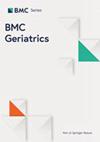Association between healthy lifestyle and frailty in adults and mediating role of weight-adjusted waist index: results from NHANES
IF 3.8
2区 医学
Q2 GERIATRICS & GERONTOLOGY
引用次数: 0
Abstract
The relationship between healthy lifestyle and frailty remains unclear. Healthy weight is crucial for overall well-being, but using body mass index (BMI) to evaluate weight management is inefficient. This study clarifies the association between healthy lifestyle or its factors (non-smoking, moderate drinking, healthy weight, healthy diet, sufficeint physical activity, and non-sedentary) and frailty, and the feasibility of using the weight-adjusted waist index (WWI) reflecting central obesity as an intermediate indicator. This study included 4,473 participants from the 2007–2018 National Health and Nutrition Examination Survey (NHANES). Healthy lifestyle quality was assessed by summing the scores of each healthy lifestyle factor. Frailty was assessed using a 49-item frailty index (FI), categorizing participants into robust, pre-frail, and frail. Logistic regression to investigate the association between healthy lifestyle or its factors, WWI, and frailty. Smooth curve fitting and threshold effect analyses were used to elucidate the nonlinear association. Subgroup and two other sensitivity analyses were conducted to confirm the stability of the results. A causal mediation model examined the proportion of frailty mediated by WWI. The study identified 13.98% of the participants as frail. Optimal healthy lifestyle and frailty were negatively associated (OR: 0.39, 95%CI: 0.27–0.58). Five healthy lifestyle factors (non-smoking, healthy weight, healthy diet, sufficient physical activity, and non-sedentary) were associated with a lower prevalence of frailty, with odds ratios (OR) ranging from 0.48 to 0.61. We also analyzed the association between a healthy lifestyle and WWI (OR: 0.32, 95%CI: 0.27–0.37), WWI and frailty (OR: 1.85, 95%CI: 1.59–2.16). A positive association between WWI and FI was observed beyond the inflection point (9.99) (OR: 0.03, 95%CI: 0.02–0.03). Subgroup and sensitivity analyses confirmed stable associations between healthy lifestyle, WWI, and frailty. WWI partially mediated the association between a healthy lifestyle and frailty (mediating ratio = 20.50–20.65%). An optimal healthy lifestyle and positive healthy lifestyle factors are associated with a lower incidence of frailty. WWI may mediate the relationship between a healthy lifestyle and frailty.成人健康生活方式与虚弱之间的关系以及体重调整后腰围指数的中介作用:NHANES 的结果
健康生活方式与虚弱之间的关系仍不明确。健康体重对整体健康至关重要,但使用体重指数(BMI)来评估体重管理并不有效。本研究阐明了健康生活方式或其因素(不吸烟、适量饮酒、健康体重、健康饮食、足够的体力活动和不久坐)与虚弱之间的关系,以及使用反映中心性肥胖的体重调整腰围指数(WWI)作为中间指标的可行性。这项研究纳入了 2007-2018 年美国国家健康与营养调查(NHANES)的 4473 名参与者。健康生活方式质量是通过对每个健康生活方式因素的得分求和来评估的。虚弱程度采用 49 项虚弱指数(FI)进行评估,将参与者分为体格健壮者、前期虚弱者和虚弱者。采用逻辑回归法研究健康生活方式或其因素、WWI 和虚弱之间的关系。平滑曲线拟合和阈值效应分析用于阐明非线性关联。为了确认结果的稳定性,还进行了分组分析和其他两项敏感性分析。因果中介模型检验了一战导致的虚弱比例。研究发现,13.98% 的参与者体弱。最佳健康生活方式与体弱呈负相关(OR:0.39,95%CI:0.27-0.58)。五种健康的生活方式(不吸烟、健康体重、健康饮食、充足的体育锻炼和不久坐)与较低的虚弱患病率相关,其几率比(OR)在 0.48 至 0.61 之间。我们还分析了健康生活方式与 WWI(OR:0.32,95%CI:0.27-0.37)、WWI 与虚弱(OR:1.85,95%CI:1.59-2.16)之间的关系。在拐点(9.99)之后,WWI 和 FI 之间出现了正相关(OR:0.03,95%CI:0.02-0.03)。分组分析和敏感性分析证实了健康生活方式、WWI 和虚弱之间的稳定联系。WWI部分介导了健康生活方式与虚弱之间的关系(介导比=20.50-20.65%)。最佳健康生活方式和积极的健康生活方式因素与较低的虚弱发生率有关。WWI可能是健康生活方式与虚弱之间关系的中介。
本文章由计算机程序翻译,如有差异,请以英文原文为准。
求助全文
约1分钟内获得全文
求助全文
来源期刊

BMC Geriatrics
GERIATRICS & GERONTOLOGY-
CiteScore
5.70
自引率
7.30%
发文量
873
审稿时长
20 weeks
期刊介绍:
BMC Geriatrics is an open access journal publishing original peer-reviewed research articles in all aspects of the health and healthcare of older people, including the effects of healthcare systems and policies. The journal also welcomes research focused on the aging process, including cellular, genetic, and physiological processes and cognitive modifications.
 求助内容:
求助内容: 应助结果提醒方式:
应助结果提醒方式:


